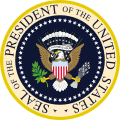BEP engraved portrait of Madison as president. | |
| Date | March 4, 1809 |
|---|---|
| Location | United States Capitol, Washington, D.C. |
| Participants | James Madison 4th president of the United States — Assuming office John Marshall Chief Justice of the United States — Administering oath George Clinton 4th vice president of the United States — Assuming office |
| ||
|---|---|---|
4th President of the United States
Tenure
Electoral history Legacy  | ||
The first inauguration of James Madison as the fourth president of the United States was held on Saturday, March 4, 1809, in the chamber of the House of Representatives at the United States Capitol in Washington, D.C. The inauguration marked the commencement of the first four-year term of James Madison as president and the second term of George Clinton as vice president. The presidential oath was administered by Chief Justice John Marshall. The President wore a 100% American-made wool suit, and the first official inaugural ball occurred at Long's Hotel, with ticket prices being $4 (currently about $80). [1] Clinton died 3 years, 47 days into this term, and the office remained vacant for the balance of it. (Prior to ratification of the Twenty-fifth Amendment in 1967, no constitutional provision existed for filling an intra-term vacancy in the vice presidency.) Clinton was the first vice president to die in office.

